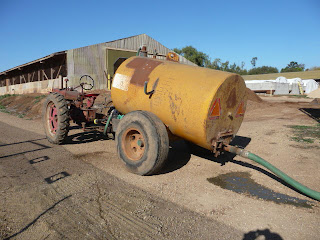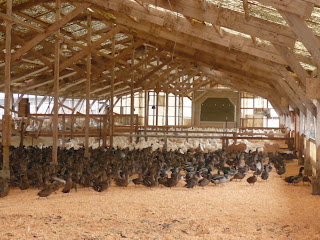Every year in November and December we have several buildings that have to be emptied, cleaned, disinfected and made ready for next year's duck breeders. Whether you are cleaning a 7200 sq. ft. building or a backyard coop, the process is the same. I will show you the steps we follow, using our Building 3 as an example.
1) Before you do anything else, make sure your rodent bait stations are full. Typically you remove feed from the building or put it away for a brief time when you clean. If you have any rodents, their normal feed may be gone and they will be looking for alternative sources. They may now eat that bait that has otherwise been ignored.
2) Move your birds out of the building. This may be as simple as putting them outside for the day or moving them to a new pen. The best time to clean a building is when that flock is done laying - either they are molting or you will sell them. We do not clean out the litter until a flock is leaving and a new one is coming in - once a year. We add bedding once or twice a week so by the end of a year, it is up to 12" deep.
 |
| Moving the old breeders to our Sell Pen. |
3) Remove all equipment from the building: nest boxes, fences, feeders, floors under waterers, etc. Ideally you can use a pressure washer to wash all your equipment. Remove all the dirt and organic matter with the first wash. Then use a disinfectant to sanitize everything. There are various types of disinfectants available: chlorines, iodines, phenols and quats. Disinfectants containing phenols seem to be most effective in cleaning our buildings.
 |
| The divider fences are out. Nacho, Juan and Guillermo are now removing nest boxes and feeders. |
 |
| Nacho washing fences, ramps to the waterers, feeders, etc. |
4) Remove all the bedding and manure from the building. This is an excellent soil amendment as is or pile and compost it before adding it to your soil. The carbon:nitrogen ratio is perfect for our litter so it composts quite rapidly on its own after removal. When you remove the bedding, oxygen is added with all the mixing. This oxygen rejuvenates the bacteria in the bedding and often we see water vapor rising from the heating piles of bedding within a day or two of removal.
 |
| Guillermo is using the Bobcat to clean near the waterers, notice the bedding is moist. |
 |
| Juan is cleaning where most of the nests are - opposite the waterers - notice the drier litter. |
Keep in mind that if you do not frequently remove your litter, a very slow composting process is occurring in the deep litter. It will not heat up excessively as it is starved for oxygen. But this low level of composting does provide some warmth to your birds during a cold winter.
5) Use the same pressure washer to wash the interior of the building. Follow up with a second washing using disinfectant - as you did with the equipment.
 |
| Nacho is washing the entire interior - ceiling and walls. |
6) We have a 5' wide concrete pit with a wire floor along one wall of the building. Above this are the nipple waterers. Any leakage from the nipple waterers goes in these pits, along with the manure produced while the birds are drinking or lounging on the wire. During the year we periodically pump these these pits but we empty and wash them completely at cleanout.
 |
| Juan washing out the pits. |
 |
| PTO powered manure pump. |
 |
| Pits after cleaning. We put rodent bait stations below the white ramps. |
7) It is best to let the building completely dry before you put a 2'-3" layer of bedding back in for your birds. Then add your disinfected feeders, nest boxes and other equipment.
 |
| Installing the divider fences. |
8) Be gentle when you move in your new flock. It is a major stress on them if it is a new environment for them.
 |
| Juan and Luis moving in a flock of White Crested breeders. |
 |
| We use these coops to move in our Mallard breeders. Notice the feathers on the floor from our clipping their wings. |
9) If it is a new flock of birds, monitor them carefully. Can they find the feed and water? Is anything disturbing them? Remember, they might be in a completely different environment and it is stressful for them - just as it would be for you! If you want to provide a low level of light during the night, get a night light from a local hardware or drug store. Buy one that has a photocell so it comes on when the sun goes down and turns off when the sun comes up. Just plug it into an electrical outlet. Keep it below 10 watts.
10) You now have a clean building, clean bedding, clean equipment, fewer rodents and a group of birds that are ready to lay eggs for you.
 |
Our young breeders in their new, clean building!
|
















I would like to discuss with you about my duck eggs. I have 10 in the incubator now do I need to turn them daily. they have a auto turner in their. I have never done this before and a little nervous. cmsday86@gmail.com
ReplyDeleteI am new to raising ducks. We have 3 (sex?) that are 2 1/2 months old.We made a large pen (12'x12'). They have a plastic pool to swim in (clean running water daily).I bring them in at night as we have yet to make the floor of their house(half of an old wooden shed,(6'x 5').We will have very cold winters here in very northern calif.(gets down to -19 some days).I need help as to what type of floor to put down that I can clean and yet will be safe and draft free for them.Does anyone have suggestions? I would welcome suggestions from those who have been there done that! I have been told not to use sawdust as bedding,any other suggestions? We live on a ranch. Is straw ok? What to do about mice?
ReplyDeleteThanks. K.
Most people use a dirt floor but if you want to clean it, a concrete or wood would be better. Because of the moisture, concrete is probably better. Shavings are probably the best as they are the most absorbent. The disadvantage of straw is it does not absorb moisture well and is harder to get out once you go to clean the building (envision tangle spaghetti that does not break) though it is typically much cheaper than shavings. Sawdust is not good if too dusty or when used with babies (as they may think that is what they are supposed to eat). Otherwise it is okay.
ReplyDeleteJohn what do you use as bedding material for your babies then ?
ReplyDeleteWe use wood shavings as bedding for all our birds.
DeleteWhere or who do you guys sell the older ducks to? Can people stop by and buy older birds?
ReplyDeleteWe sell the older breeders for meat for the Asian market. No, we do not sell them to anyone else. We actually meet our buyer 25 miles away to transfer the birds to his truck. For biosecurity reasons we do not want his vehicle on our property.
ReplyDeleteSo the duck coop only needs to be cleaned out once a year?
ReplyDeleteFor us this works. We are adding shavings once or twice a week so it stays dry for the birds. The buildup does not come into contact with much wood. This allows us to not disturb the birds. I am not saying everyone has to do it our way. It just works for us.
ReplyDeleteI bought two buff geese from you this past spring and we love them to pieces. The weather is getting really cold -4 they say tomorrow, it doesn't seem to be effecting them much and I still fill up their pool for the (is this a smart idea) is one question and do the typically breed when it's this cold? They've been trying for the last two days.
ReplyDeleteIf you want to go to the trouble of providing swimming water, go ahead. But they do not require it for normal health or breeding. Typically breeding starts in late January to mid March, depending on your location. But oftentimes the first year's schedule in a bit abnormal. But, don't worry, it won't harm them. I just wouldn't let her set on a nest of eggs. Remove them as she lays them, if she lays them.
DeleteHi John,
ReplyDeleteWe ordered some of your golden 300s 2 falls ago and enjoy their addition to our flock. We will be ordering a bunch more next fall if we get a barn made specifically for layer ducks. if you dont mind I would like to ask you about the dimensions of your barns and their capacities. How wide by how long and how many ducks per a divider or barn?
The buildings above are 40' wide and we try to give the birds at least 4 sq.ft. each. So if you had a flock of 200, the pen would be 40'x20'. Glad things are going well with your Golden 300s!
Delete